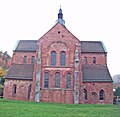Eusserthal Monastery
| Eusserthal Cistercian Abbey | |
|---|---|
 Monastery church from the southeast |
|
| location | Germany Rhineland-Palatinate |
| Coordinates: | 49 ° 14 '30 " N , 7 ° 58' 13" E |
| Serial number according to Janauschek |
290 |
| founding year | 1148 |
| Year of dissolution / annulment |
1561 |
| Mother monastery | Villers-Bettnach Abbey |
| Primary Abbey | Morimond Monastery |
|
Daughter monasteries |
no |
The Eusserthal Monastery is a former Cistercian abbey in Eusserthal near Annweiler am Trifels . Only the front part of the former monastery church has survived from the monastery and is now used as a parish church.
history
The monastery was founded in 1148 by the knight Stephan von Mörlheim and settled with Cistercian monks from the monastery Villers-Bettnach in Lorraine ( filiation of Morimond ). The main task of the monastery was initially to reclaim the valley. In 1186 the monastery was placed under imperial protection by Frederick I Barbarossa and received numerous donations. Among other things, he owned numerous vineyards in the southern Palatinate . The monks worked at Trifels Castle as chaplain and guarded the imperial regalia during their storage time in the castle in the 12th and 13th centuries. After that, the importance of the monastery decreased significantly.
A settlement quickly developed around the monastery. The monastery was looted several times in the 15th century. During the Peasants' War in 1525, the monastery was looted and set on fire; it was rebuilt in 1552 by Abbot Martin II. In 1561, Elector Friedrich III. abolish the monastery as a result of the Reformation .
The village now belonged to the Electoral Palatinate . In 1591 Eusserthal received its own parish. In the 17th and 18th centuries, several attempts were made to revive the monastery, but they failed.
A priory in Mörlheim belonged to the Eusserthal monastery .
At his own request, the Speyer bishop Friedrich von Bolanden was buried in 1302 in the monastery church in Eusserthal. The grave is no longer recognizable there, but the inscription has survived.
From 1297–1306 Heinrich von Metz († 1336) officiated here as abbot ; 1306–1309 he held the same office in the Eusserthal mother monastery Weiler-Bettnach , 1310–1336 he was Prince-Bishop of Trient . From 1309 at the latest, he also acted as Chancellor of King Henry VII ; both were linked by a close friendship.
Church building
The church was probably started around 1220 and consecrated in 1262. The floor plan of the church is still Romanesque , but the cross vaults already show an early Gothic style. According to the custom of the Cistercians, the church has no towers, but only a roof turret on the crossing , and the interior does not have a colored design. The structure is made of red sandstone that was quarried in the area. It is a three-aisled cruciform pillar basilica with a transept . The vaults of the nave and choir are held by open buttress arches . A similarity with the earlier dated Otterberg Abbey Church , which is much larger, is unmistakable.
Today only the choir , the transept and the first yoke of the nave stand of the monastery church . The monastery buildings and the cloister have disappeared. What remains are still the tracery - rosette in the wall of the choir and a well-preserved Relief of sandstone, showing a dragon. The interpretation of this figure on a door arch is uncertain.
In the 18th century the remains of the church were set up as a parish church. For this purpose, the upper window openings were drawn in and, after the ruins of the nave were demolished, a new, simple west facade with an entrance door was built. As a result, the building now has the character of a central building . The acoustics are ideal for church music events. The summer concerts in the monastery church are known nationwide. In 1961, extensive restorations took place on the building fabric, which brought the Romanesque character of the building back to bear.
The organ in the south transept has 23 registers on two manuals and a pedal and was built by the Hassloch master organ builder Hugo Wehr in the 1970s.
On the inner southern choir arch there is a coat of arms inscription from the 16th century. The coat of arms is that of the von Mörlheim founding family , which can also be seen on a coat of arms stone in the outer east facade (two pairs of hands, arranged one above the other). The Latin inscription translates as: "The coat of arms of Mr. Stephan, the strict and noble knight of Merlnheim, who founded this monastery in 1148" .
gallery
literature
- Heribert Feldhaus: The former Cistercian monastery Eusserthal , Imhof Petersberg 2008, ISBN 3-86568-255-3
- Anton Doll: Observations on the beginnings of the Cistercian monastery Eusserthal , in: Mitteilungen des Historisches Verein der Pfalz , 68th volume, Speyer, 1970 (article as PDF document)
Web links
- Karlsruhe: Eußerthal (pictures) Photos of the monastery church in the Stadtwiki Karlsruhe
Individual evidence
- ^ Franz Xaver Remling : History of the Bishops of Speyer , Volume 1, Mainz, 1852, p. 553; (Digital scan)
- ↑ Historisches Jahrbuch , Volume 29, p. 284, Görres-Gesellschaft, 1908; (Detail scan)
- ^ Franz Xaver Remling : Documentary history of the former abbeys and monasteries in what is now Rhine Bavaria , Volume 1, Neustadt / Haardt, 1836, p. 186; (Digital scan)










